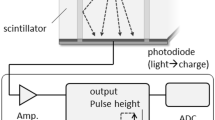Abstract
Tomography is a powerful technique to obtain accurate images of the interior of an object in a nondestructive way. Conventional reconstruction algorithms, such as filtered backprojection, require many projections to obtain high quality reconstructions. If the object of interest is known in advance to consist of only a few different materials, corresponding to known image intensities, the use of this prior knowledge in the reconstruction procedure can dramatically reduce the number of required projections.
In previous work we proposed a network flow algorithm for reconstructing a binary image defined on a lattice from its projections. In this paper we propose a new algorithm for the reconstruction of binary images that do not have an intrinsic lattice structure and are defined on a continuous domain, from a small number of their projections.
Our algorithm relies on the fact that the problem of reconstructing an image from only two projections can be formulated as a network flow problem in a graph. We derive this formulation for parallel beam and fan beam tomography and show how it can be used to compute binary reconstructions from more than two projections.
Our algorithm is capable of computing high quality reconstructions from very few projections. We evaluate its performance on both simulated and real experimental projection data and compare it to other reconstruction algorithms.
Similar content being viewed by others
References
Ahuja, R.K., Magnanti, T.L., Orlin, J.B.: Network Flows: Theory, Algorithms and Applications. Prentice-Hall, Englewood Cliffs (1993)
Batenburg, K.J.: A new algorithm for 3D binary tomography. Electron. Notes Discrete Math. 20, 247–261 (2005)
Batenburg, K.J.: A network flow algorithm for reconstructing binary images from discrete X-rays. J. Math. Imaging Vis. 27(2), 175–191 (2007)
Bertsekas, D.P., Tseng, P.: RELAX-IV: a faster version of the RELAX code for solving minimum cost flow problems. LIDS Technical Report LIDS-P-2276, MIT (1994)
Censor, Y.: Binary steering in discrete tomography reconstruction with sequential and simultaneous iterative algorithms. Linear Algebra Appl. 339, 111–124 (2001)
Fishburn, P., Schwander, P., Shepp, L., Vanderbei, R.: The discrete Radon transform and its approximate inversion via linear programming. Discrete Appl. Math. 75, 39–61 (1997)
Gale, D.: A theorem on flows in networks. Pac. J. Math. 7, 1073–1082 (1957)
Gardner, R.J.: Geometric Tomography, 2nd edn. Cambridge University Press, New York (2006)
Gardner, R.J., Gritzmann, P., Prangenberg, D.: On the computational complexity of reconstructing lattice sets from their X-rays. Discrete Math. 202, 45–71 (1999)
Goldberg, A.V., Tarjan, R.E.: Finding minimum-cost circulations by successive approximations. Math. Oper. Res. 15, 430–466 (1990)
Herman, G.T., Kuba, A. (eds.): Discrete Tomography: Foundations, Algorithms and Applications. Birkhäuser, Basel (1999)
Herman, G.T., Kuba, A. (eds.): Advances in Discrete Tomography and Its Applications. Birkhäuser, Basel (2007)
ILOG CPLEX: http://www.ilog.com/products/cplex/
Jinschek, J.R., Calderon, H.A., Batenburg, K.J., Radmilovic, V., Kisielowski, C.: Discrete tomography of Ga and InGa particles from HREM image simulation and exit wave reconstruction. MRS Proc. 839, 4.5.1–4.5.6 (2004)
Kak, A.C., Slaney, M.: Principles of Computerized Tomographic Imaging. SIAM, Philadelphia (2001)
Natterer, F.: The Mathematics of Computerized Tomography. SIAM, Philadelphia (2001)
O’Rourke, J.: Computational Geometry in C. Cambridge University Press, Cambridge (2001)
Schrijver, A.: Combinatorial Optimization: Polyhedra and Efficiency. Algorithms and Combinatorics series, vol. 24. Springer, Heidelberg (2003)
Schüle, T., Schnörr, C., Weber, S., Hornegger, J.: Discrete tomography by convex-concave regularization and D.C. programming. Discrete Appl. Math. 151, 229–243 (2005)
Weber, S., Schnörr, C., Hornegger, J.: A linear programming relaxation for binary tomography with smoothness priors. Electron. Notes Discrete Math. 12 (2003)
Weber, S., Schüle, T., Schnörr, C., Hornegger, J.: A linear programming approach to limited angle 3D reconstruction from DSA projections. Methods Inf. Med. 4, 320–326 (2004)
Weber, S., Schüle, T., Hornegger, J., Schnörr, C.: Binary tomography by iterating linear programs from noisy projections. In: Proc. of IWCIA 2004. Lecture Notes in Computer Science vol. 3322, pp. 38–51 (2004)
Author information
Authors and Affiliations
Corresponding author
Rights and permissions
About this article
Cite this article
Batenburg, K.J. A Network Flow Algorithm for Reconstructing Binary Images from Continuous X-rays. J Math Imaging Vis 30, 231–248 (2008). https://doi.org/10.1007/s10851-007-0053-2
Received:
Revised:
Accepted:
Published:
Issue Date:
DOI: https://doi.org/10.1007/s10851-007-0053-2




